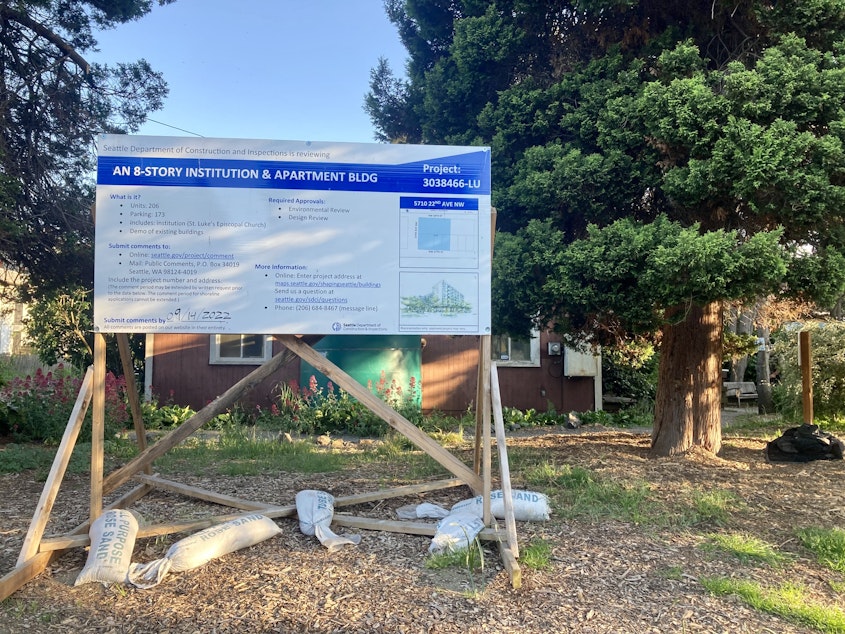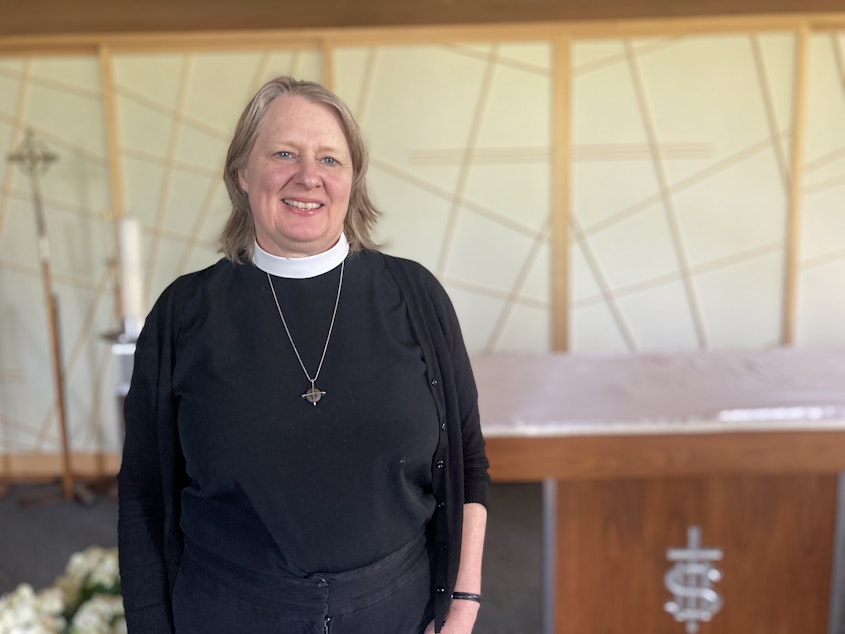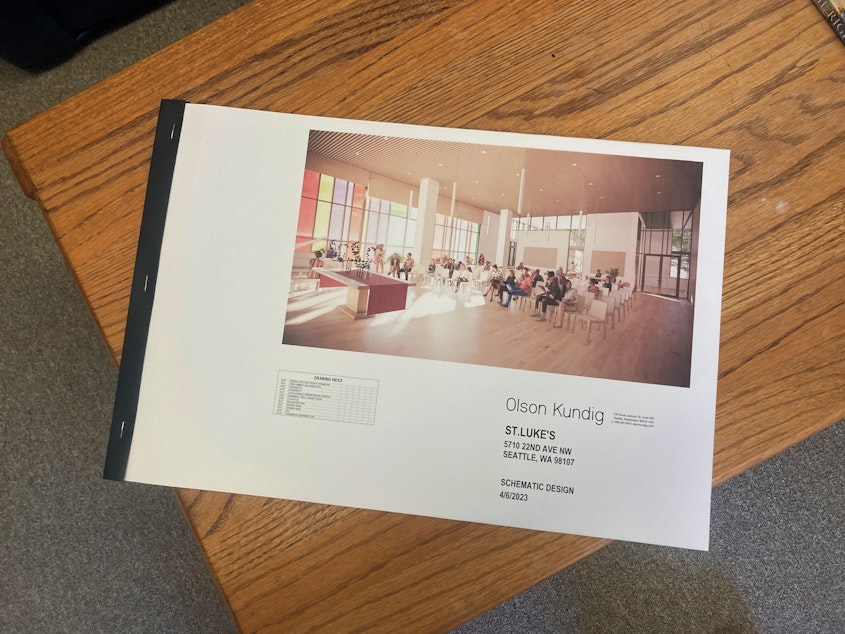What will be the future of church in Seattle?

For churches that own large pieces of property, what was once a blessing can become more of a curse, especially as membership wanes.
St. John United Lutheran Church in Phinney Ridge is at a “crossroad.”
That’s how Pastor Anna Rieke described it in a message sent out to church congregants and everyone else that uses the building.
The church takes up a full city block, with a large parking lot as well as a garden space, and a three-story building.
While the lot remains large, the congregation at St. John is shrinking. On the books, Pastor Rieke said they have 110 people in their worship community. But at services every Sunday, it’s more like 25 to 35.
Sponsored
The building is in good condition. But financially, it’s just not sustainable.
"In a small congregation like this, with folks who are already, in the later years of life, a good portion of them, we've lost some really key members," Pastor Rieke said.
While church membership may be dwindling, Pastor Rieke said lots of other people use the building every day — a local choir meets here, so do groups like Alcoholics Anonymous and Narcotics Anonymous. There’s also a free hot-meal program.
And part of the building is also rented out to nonprofit organizations, like an environmental-based ministry program, as well the Lutheran bishop’s office.
But a dwindling congregation means dwindling tithes, and the property is just too expensive for the church to maintain and manage.
Sponsored
Pastor Rieke does have some ideas for what comes next.
"I think my dream would be to find a way for this property to be managed by the people who use it, and still centering those who most need this space and who have far fewer options in the city for what's offered here. But we'll see. There has to be an appetite for that and the resources behind it to make that happen."
But for her, rethinking things is a question that’s bigger than just, "How does the church maintain its property?"
It’s an opportunity to understand and plan for the future of organized religion in America.
"I think Seattle is on the cutting edge of a national problem," Pastor Rieke said. "The church is no longer the same center of community life that it was. So a new model has to take into account — one, how many people are engaging with church, and also the different ways people are engaging with church.
Sponsored
"I would love to see my denomination come up with some really bold, justice-centered, faithful, best practices in this new climate. Because some people for example, will still say, 'Well, we need new members.' That's not realistic. You're not going to get enough new members to prop up this old model. And I don't think it's ethical. You know, I think that's rooted in colonization. I don't think we should be out there trying to convert people if they're not up for it. And a lot of people clearly aren't."
Seattle is not known for being a religious town.
Clergy often refer to Seattle as “the none-zone,” as in, when asked by a survey what religion they are, a lot of Seattleites check the “none” box.
In a gallup poll from 2017, that “none” number was 47% of the adult population in Washington.
Can a place often defined by what it’s not — i.e. religious — be the space where religious organizations figure out a new purpose moving forward?
Sponsored
Pastor Rieke and her congregation are just getting started with working out what their church is going to look like in the future. Other churches are further along the process.

St. Luke’s Episcopal Church is just a 10-minute drive from St. John, in the middle of downtown Ballard. Like St. John, the church spans a full city block, occupying 55,000 square feet of land.
The campus has 10 buildings, including an old chapel, a new chapel, a community garden, cottages where students at the theological seminary, The Seattle School, can stay, and a community feeding program called Edible Hope.
Soon, they’ll all be torn down.
Sponsored
The Rev. Canon Britt Olson, the vicar at St. Luke's, said what’s going in is something vital to the community — housing.
"We are going to be building two eight-story buildings, one which will be all affordable housing for people making 30-60% of the area median income, and one which will be mixed market rate and affordable workforce housing, as well as a brand new space all on one level for our congregation and for our ministries, and for other people in the community to use this beautiful new space," Canon Olson said.
The congregation at St. Luke’s has actually grown in recent years, but even so, Canon Olson said maintenance of those old buildings is too expensive. Just bringing their old chapel up to ADA accessibility requirements would cost $1.5 million. It just didn’t pencil out.
St. Luke’s will keep its land. Two developers — one working in affordable housing, the other in market rate — will lease that land from them for the next 100 years. The developers will run the housing, the church will receive ground lease rent, and in 100 years, they can all reconsider how to move forward.
As for where members will hold services, the church will also own a condo on the ground floor of one of the buildings.
Canon Olson said the change will be “life giving.”

The buildings that will be going up on St. Lukes' property are big — eight-story buildings, 206 apartments total.
It’s a lot of new housing for the neighborhood. It’s also a big change, aesthetically. Gone will be the old chapel, the old but cute buildings spread across the campus.
It’s a big change and a big bet — that doing this will be what the congregation needs to survive, as well as what’s best for the community at large.
But Michael Trice said it’s not actually a new idea.
"The sacred texts, not just in the Christian tradition, but across the kind of religious, moral codes of conduct gives a preferential option to those who are marginalized in your communities, to widows and orphans, to those who are voiceless, and who have less power than yourself," said Trice, a professor and director at Seattle University's Center for Ecumenical and Interreligious Engagement, and an Evangelical Lutheran pastor. He said churches are at their best when they help those in need.
Changing the way your church looks, or the way it works, won’t be popular with everyone. But Trice said that’s not really the point.
"It will mean many of these congregations, many of these religious organizations, will get smaller," he said. "But if we interpret the strength of a religious community by the size of the people in it, by its quantity, we'll have missed what the quality is of what they're actually bringing to the world."
Trice also acknowledged other reasons that people may not be crowding to church. Historically, churches haven’t been comfortable or welcoming places for many people.
Reaching the people they want to help will have to be done with care and humility.
"At heart of it is in fact, 'Can I trust? Can I trust those smaller organizations who tell me they want to help provide housing to marginalized communities? If I know they've been a part of a history where they didn't want to provide safe spaces to my people, or other people?' And my response is, you have to look in the history and find their apologies. And what they did next. And I think providing housing is a part of what they did next."

But not every church is in the same boat.
For some, bringing community back isn’t just dependent on apologies, or rethinking a religious structure.
It’s also about physically bringing the community back, something some churches are uniquely suited to do.
"It is where Black community finds itself. It is where, even the fractured Black community now that we have in central Seattle is still there," said Donald King, president and CEO of the Nehemiah Initiative Seattle.
"We're a faith-based development initiative," King said. "And our mission is to disrupt the displacement of the African-American community from urban centers and the retention of what is the historically Black faith-based organizations in central Seattle. And we do that through the development of affordable homes, community spaces and business places on the underutilized property of those faith-based organizations."
King said, as gentrification pushed Black residents out of places like the Central District, churches also began to fail, because their congregation no longer lived in the neighborhood.
"Churches found themselves in a position to say, you know, 'Well, what do we do now?'" he said.
Many of the churches that were left behind are what King describes as property rich, but cash poor. Like St. John, they’re sitting on land that is often paid off, and extremely valuable. Plus, as religious institutions, they don’t pay property taxes. But they don’t have much in actual cash savings.
King said this is a chance to use that property wealth to better the community and for local churches to consider taking on a new mission.
"The major source of wealth in our country is through the ownership of homes and Black families have had barriers for decades, if not centuries from being able to own property," King said. "How can this become a new mission for the church in finding ways to provide homeownership opportunities and closing that wealth gap, providing generational wealth for Black families by ownership of their home?"
The Nehemiah Initiative helps participating churches set up land trusts on their properties. What exactly that looks like depends on the location and the church, but in most cases the actual church building will remain, while apartments, or single-family homes are built around them on the property. These will be affordable homes, sold to Black families. Those families will own the space they live in, but, like St. Luke’s, the church will own the land.
Two churches are in the pre-development phase with the initiative, and three more are waiting to begin. King said they’ll all be in pre-development by the end of 2023.
King is optimistic the model will spread, but he said the idea hasn’t always been an easy sell for local congregations.
"This is property that was hard won; this is property that was purchased, from offerings from the congregation; this is property and redlined neighborhoods where you couldn't borrow money to purchase property," King said. "So with the history of loss of property, and that is still in decline in the Black community, it is very difficult for them to talk about the use of their property in a way that could be lost for their use."
Even with the promise of help it can bring some, change is still a form of loss for others.
Changing the way churches operate could be the key for better serving congregants, and the broader community. But it also means letting go.
That’s hard for the clergy, like Pastor Rieke, who are unsure what their role looks like in a smaller, less centralized church.
It’s also hard for the current congregants, like Barbara Reid.
"I'm a traditionalist," Reid said. "I'd love to see everything continue the way it is."
Pastor Rieke said she's anticipating hard times as the church makes decisions about what to do.
"There's more to come," she said. "And so it's good we're excited now, but it's gonna get harder. Because there's going to be tough choices to make. And there's a lot of pride in this place; people have taken really good care of this property. So yeah, it's gonna get harder. It's gonna get harder."
Despite her desire for things to continue the way they are now, Reid said she believes the church is important, in whatever form it takes.
"One of the things that's important to me that people realize in the process is that we can still be an organization, a church, without a building, or with a whole different vision of what a church building is," Reid said. "And I think we're headed in the right direction."





